So you want to make nitroglycerine, AGAIN, ...
Okay, let's do it !!
The stuff needed for making NG:

- 100 ml of >95% H2SO4 (sulfuric acid)
- 70 ml of 65% HNO3 (nitric acid)
- 22 ml of 100% C3H5(OH)3 (glycerol)
- At least 0.5 kg of ice for cooling and optional some NH4NO3
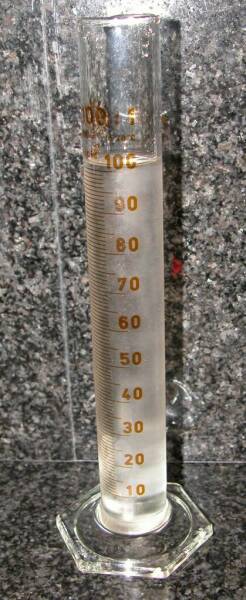
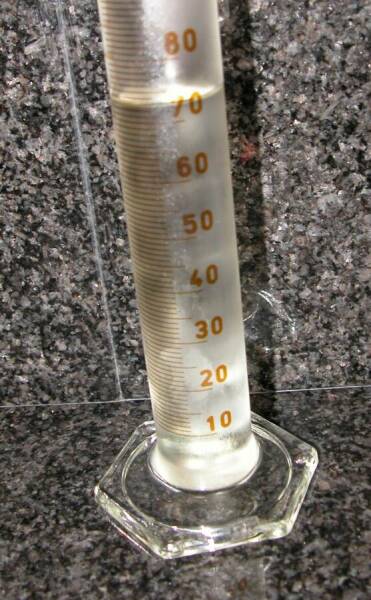

From left to right: the 100 ml H2SO4, the 70 ml HNO3 and the 22 ml C3H5(OH)3
Sharp observers; I put a bit more then 23 ml glycerol in the measuring cylinder, because with
a viscous fluid like this one, alot of product will stick to the sides ...
============RANT============
I can not stress this enough:
Because this synthese involves a pretty sensitive high explosive, you must NEVER let temperature rise over 20°C !!!!
When temperature gets over a certain point (rough guess, about 40°C) a runaway reaction will occur, which itself generates
a lot of heat, and thus is self-sustaining. If, due to some crazy, totally "out there" reason, runaway does occur,
try to stay as calm as possible. Pour the entire red fuming and bubbling mix in at least the double volume of cold water.
The reaction will stop, and you can go extract your NG, no harm done (if you don't suffer a heart-attack)
BTW: If you do happen to suffer a hearth attack (wuss) you might want to use the stuff you just made.
Dip your finger in the NG and put it in your mounth, it will taste very sweet, and you'll get a head-ache
within a minute, that's because the nitroglycerine widens your blood vessels in your brain, but I guess it beats dying.
You don't want more then 0.25 ml in your body, because then you'll probably go pretty sick/dead ...
===========END OF RANT==========
Now let's get busy :)
First, pour the H2SO4 in the beaker in the ice bath, then, slowly add the HNO3, keeping an eye on the temperature.

Here, the HNO3 is being added to the H2SO4. Now look what happens next:
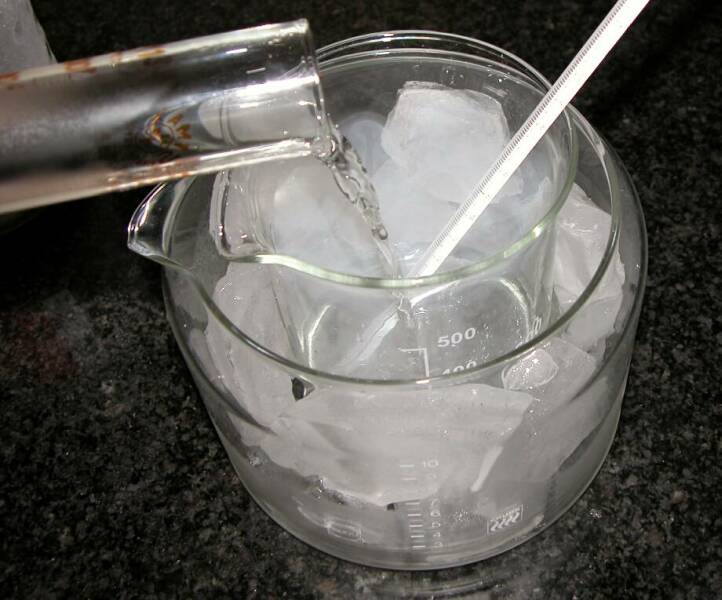


With my pre-chilled acids (straight from the freezer) the temperature shot up from the sub-zero realm (-5°C for sure,
look at the ice condensing on the bottles in the first pic) to a nice hot 40-50°C, while evolving HNO3 vapours.
So I suggest doing this step slowly!! Especially when this synth is performed indoors ...
(HINT from Vulture : adding the H2SO4 to the HNO3 while stirring will be better for temperature control)
Meanwhile, I fled the scene getting this from my lab:

77% NH4NO3 prills (the other 23 % is a carbonate coating).
They help to keep the temperature down as they dissolve, so I added about 300 grams of these to my icebath:

Now wait untill the temperature has dropped to around 10°C, and then slowly start adding glycerine.

After each individual addition, you must stir the mix, so the glycerine can't form a layer above the acids.

If the temperature gets around 15°C, immediatly stop the addition, and keep stirring to distribute the heat evenly.

When it has cooled down again, you can resume adding the glycerine in small portions at a time.

Constantly keep one eye on the mercury, and don't stop stirring.
With this "leet" cooling bath I was able to add the 22 ml of glycerine in just 15 minutes :)

When all the glycerine is added, allow the reaction to complete for 15 minutes while stirring now and then.
The next step is to water the acid down, wich will produce quite some heat too.
(allways add acid to water, not the other way around)
Use the double volume in cold water for this and you'll be fine, just pour it all in at once.


Now pour off the spent acids, add more fresh water and pour this off again. Now add a bit more fresh water.

You'll notice some white blobs on the bottom of the reaction vessel. This is your NG !!
Now measure the pH. I used pH paper with a 1-14 range:

As you can see in the pic below, it still very acidic; pH 1 or less ...

To get "rid" of an acid, you need to add a base, I used Ammonia:
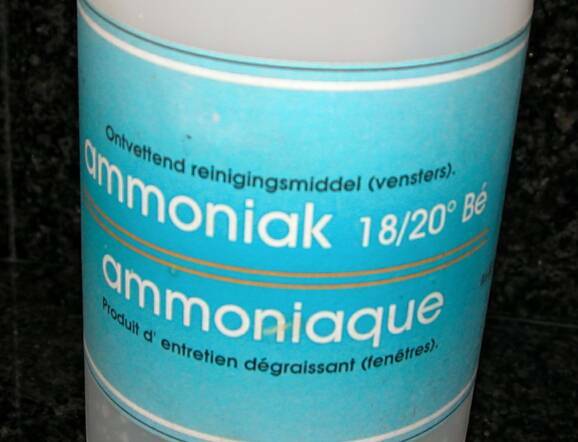
As long as the pH is below 7, add more ammonia (while stirring good) untill it is a little bit basic.
When using a high concentration of a strong base, add very small portions between measurements, because too basic is just as bad as too acidic !

My pH was between 7 and 8, it doesn't show up well on the picture, but the pH paper is a bit greenish. Good enough :)

Now suck the NG out of the slightly basic solution, wash with a bit distilled water to remove
remaining minerals, and transfer it to a measuring cylinder to check out your yield.

I can't say I'm very thrilled, because from my 22 ml of glycerine, I got 19 ml of NG.
I blame bad yield on the water in the reaction ...
Now it's time to get the water out of your glycerinetrinitrate. We learned from past experience that
the saturated NaCl solution is not a good way to go, so just place it in a shallow container in an improvised dessicator.
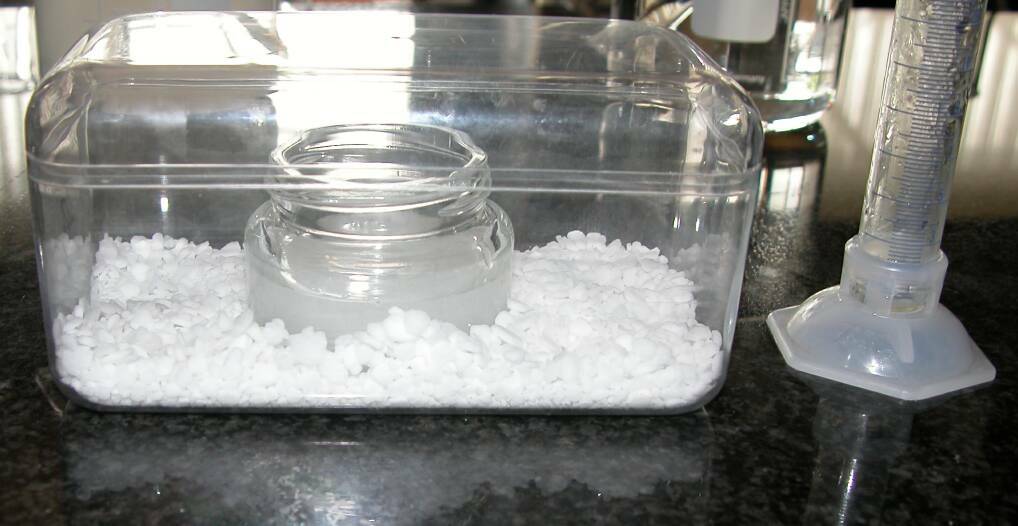
Dessicating agent presented here is CaCl2, but there are lots of other options.
How long it takes untill all the water to evaporate out of your NG, depends on many factors; surface area of your NG, temperature, dessicant, airflow over the surface, ...
You can tell if all the water is out, because the NG is nice and clear.
2 days later:

It's a bit hard to see, but that is 18.5 ml NG. I'm happy with it, but still not thrilled ...
I need higer % HNO3 ...
========================From previous experiments========================
The reaction when it detonates:
4C3H5(NO3)3 (l) --> 12CO2 (g) + 10H2O (g) + 6N2 (g) + O2 (g)
You notice for every 4 molecules of NG that detonate, you get 1 molecule of O2 left over ...
So you may want to add some fuel ... I guess any fuel will do, as long as it's not acidic.
For example Al powder, graphite, other explosives with a negative oxygen balance, ...
Testing season is open:

This 20 ml (30 gram) NG was combined with 1.5 gram NC in acetone solution and 1.5 gram 400 mesh flake Al powder (airfloat, and a mess to work with) to give ...
This flashy looking slurry :

While the acetone is evaporating out of it, some ideas on power comparing that are easy to realise with limited funding ?? => brainfevert@yahoo.com
BACK